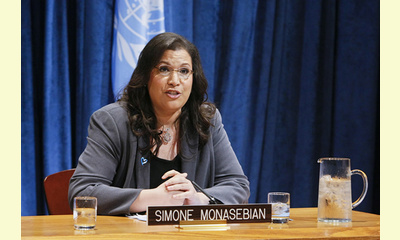|
|
Combating Human Trafficking: An Interview with Simone Monasebian [United Nations]
un articulo por Mirva Lempiainen for The Interdependent, United Nations Association of U.S.A
Human trafficking, also called modern-day slavery,
is a $32 billion-a-year international business
with an estimated 21 million victims. At any given
time, millions of women, children and men are sold
worldwide to serve as sex slaves, forced laborers
or child soldiers. Many are also killed for their
organs. That is why the United Nations has been
focusing heavily on addressing these rampant human
rights violations.

Simone Monasebian, the New York chief of the UN Office on Drugs and Crime (UNODC), moderating a press conference on the launch of the UN Trust Fund for Victims of Human Trafficking, in November 2010. (UN Photo/JC McIlwaine)
click on photo to enlarge
In May, the General Assembly organized its first
high-level meeting on human trafficking. The first
detailed report about the illegal trade came out
in late 2012, two years after the passing of the
United Nations Global Plan of Action to Combat
Trafficking in Persons. And just this month, the
UN’s International Labour Organization helped
launch a program to prevent the trafficking
of 100,000 girls and women from South Asia.
Recently, The InterDependent interviewed Simone
Monasebian, the New York chief of the United Nations
Office on Drugs and Crime (UNODC), which was
mandated to handle trafficking in 2010.
The ID: What steps has the UN taken to combat
human trafficking?
Monasebian: Three big things have happened: In the
year 2000, there was the adoption of The Protocol
to Prevent, Suppress and Punish Trafficking in
Persons, especially Women and Children. This so-
called Palermo Protocol was the first treaty that
gave a comprehensive definition of what human
trafficking is, including organ trafficking, sex
trafficking, labor trafficking and child
soldiering. Now more than three-quarters of the UN
member countries have ratified the protocol, but
the implementation of it needs to be a lot
stronger.
The next big step to happen was when the United
Nations Office on Drugs and Crime started working
on various initiatives, including the United
Nations Global Initiative to Fight Human
Trafficking (UN.GIFT) in
2007. Then, in 2010, the third big step was the
passage of the Global Plan of Action.
The ID: Why has it taken so long for the UN to
tackle this issue?
But since December 2009, they have started talking
about human trafficking as a problem even in the
Security Council. As of late, there’s more of an
understanding that it’s a security issue, not just a
human rights or a development issue.
[Note: Thank you to Janet Hudgins, the CPNN reporter
for this article.]
(This article is continued in the discussionboard)
|








|
DISCUSSION
No hay pregunta ligada a este article.
* * * * *
Comentario más reciente:
(The following is continued from the main article listed above.)
The ID: How does the UN define human trafficking?
Monasebian: The definition of human trafficking in the treaty has three aspects. One is movement, which could be kidnapping or somebody crossing the border. The UN Convention only deals with international borders, but most of the trafficking is happening nationally. You could cross state
lines, and that’s trafficking. Moving people from New Jersey to Chinatown in Manhattan, or even from Brooklyn to Queens could be trafficking. Second is the use of force and the force can be trickery. The third is the purpose—exploitation.
The ID: Who is most at risk?
Monasebian: The vast majority of people that are trafficked are women and children, mostly for sex purposes. . ... continuación.

|
|









